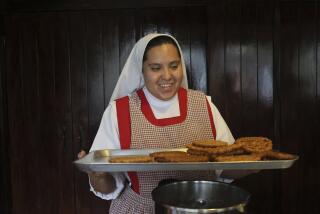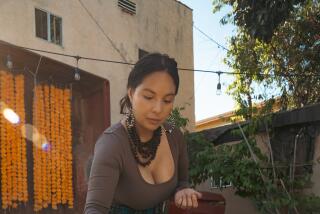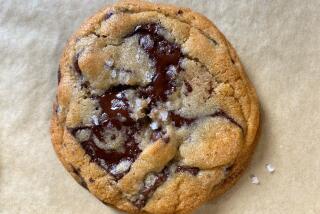That Old Sweet Story
- Share via
Some people like to think everything originated in India ages and ages ago. In the case of candy, they happen to be right. Five thousand years ago, when nobody else in the world knew anything sweet but fruits and honey, people in India were boiling down the sap of the sugar cane and making sugar.
It was a rather primitive sort of sugar, dark and only semi-solid--really, a mixture of sugar and molasses. Some form of refining began early on, though, because the Sanskrit words from which we get “sugar” and “candy” both refer to sugar crystals ( sharkara , “pebble”; khanda , “broken piece”).
Sugar eventually spread from India--but with amazing slowness, it would seem. The Greeks and the Romans imported tiny amounts, calling it “Indian salt.” In those days of limited travel and trade, it was rare and fabulously expensive.
By then, India had already developed the first two kinds of candy. The original was simply a lump of sugar crystals, what we call rock candy. Almost certainly India is also the home of candying or glaceing, where seeds, nuts, dried fruits or even vegetables are boiled or dipped in sugar syrup.
In the early Middle Ages, the Iranians developed two new kinds of candy, which the Arabs later brought west. One was marzipan ( lauzinaj ), a sweetened nut paste that is still popular in Europe. The original way of making marzipan required no technical knowledge. You mixed ground almonds with boiled-down sugar syrup, or even just with sugar dissolved in rose water.
The Iranians had also developed pulled taffy ( fanid ), a more sophisticated candy but still one that didin’t require detailed knowledge of the workings of sugar--the syrup can be cooked to either the hard ball or the soft crack stage. It was an important development, though, because when the cooled candy is pulled and twisted, the amorphous mass develops tiny crystals throughout, giving the first chewy-textured candy.
Sugar was long considered a medicine in Europe. Apothecaries would prescribe tiny amounts as a laxative or stimulant, with or without herbs or drugs added, to those who could afford it. Apothecaries also made medicinal candies called gums and pastilles, which were thickened with gum Arabic so that they would melt slowly in the mouth over a long period.
Europeans continued to look on sugar as a medicine until it became cheap, and that took a while. The Venetians started importing sugar from Egypt in the 14th Century and dominated the European candy business for the next 200 years--the process of refining sugar was perfected in Venice in 1471--but sugar was still rare and expensive until the West Indies became Europe’s chief source of sugar in the 17th Century.
When France became a center of candy-making, it must have been on the basis of a lot of Venetian know-how. We’re just guessing, though. Not a single French candy recipe was published until 1555, when the famous astrologer and physician Nostradamus gave recipes for marzipan and other candies (and noted, for the first time in print, the negative effects of hot and humid weather on candy-making).
The reason for this silence is that candy-making was long the specialty of apothecaries and the confectioners’ guilds ( confiseurs ) . When you joined a guild, you swore never to reveal the secrets of the craft. Several of the first candy recipes published appeared in books written by palace cooks, who weren’t required to join the guilds.
Columbus introduced sugar cane to the Caribbean in 1493, and when West Indian sugar became cheap and abundant, candy-making really took off. In 1677, the famous chef Francois-Pierre de La Varenne published the first description of the different densities or stages of boiling sugar syrup. On the basis of this exact knowledge, it was possible to proceed beyond the casual process of taffy-making and develop the beaten candies, with their vast variety of textures, that form the basis of candymaking today.
For instance, fondant, the filling of chocolate creams, requires syrup cooked to the soft-ball stage--no more, no less--so that when it is beaten, it forms tiny crystals, which give it its characteristic creamy texture. The members of the egg-white-candy family are distinguished by the density of the candy syrup: soft ball makes marshmallows (which also contain gelatin and are whipped and dipped in starch); hard ball makes divinity; soft crack makes nougat.
Cooks in the 17th and 18th centuries knew how to make a sort of fudge called chocolate conserve, and a sort of chocolate truffle, called chocolate olives. In those days, though, chocolate was primarily considered a beverage--and a rather difficult one to make, since you had to grind whole cocoa beans, which don’t dissolve very well in hot water. And so it went until 1825.
In that year, C.J. van Houten patented the Dutch process of cocoa-making, which separated the cocoa solids from the cocoa butter. On one hand, the cocoa powder made an easier-to-mix beverage; on the other, there was all that cocoa butter left over. In 1847, Fry & Sons of England added cocoa butter to whole ground cocoa beans and invented chocolate candy. The world has never been the same.
More to Read
Sign up for The Wild
We’ll help you find the best places to hike, bike and run, as well as the perfect silent spots for meditation and yoga.
You may occasionally receive promotional content from the Los Angeles Times.






